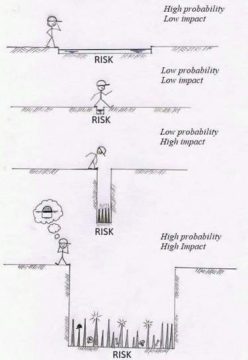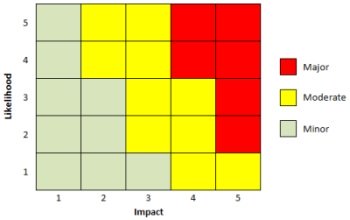Project Risk Management
Changes and Risks are inevitable, you can’t run from these. To be an effective project manager it is in your favour to plan for these calamities beforehand. The challenge with this planning is that both risks and changes are unknown and this is where Project Risk Management plays a vital role. The war room or continuous communication and face to face interaction helps in identifying the unknown.
Project Risk Management is the route to the identification, evaluation, and response to any risk that emerges and assists the project remains on track and meet its ultimate goal. Risk management is an important part of the planning process to determine the risks that might happen and how to control. As a project manager, there’s nothing better to make you sleep well at night knowing that you have got the risk to your project under control and the stakeholders know about them.
“Anything that can go wrong, will go wrong.” – Murphy’s Law
A risk is something that could potentially influence your project’s timeline, efficiency or budge. Once risks have become realities, they are defined as critical issues that need to be addressed immediately. Risk management is the process of classifying, sorting, ordering and planning for risks before they become problems. On large-scale projects, risk management stratagems may include detailed planning to make sure mitigation strategies are in place. While for smaller projects, risk management refers to simple and prioritized risks.
The risk is uncertainty and Risk management includes risk assessment and a mitigation strategy to increase the probability of positive risk and decrease the probability of negative risk.

Project Risk Management Processes
Plan Risk Management (Planning)
The very step involves the formulation of a risk management plan. It’s an important component of the overall project management plan. The process includes methodology, risk categories (marketplace, procurement, capitals, etc.) to determine the procedures for assessing risks, the risk of likelihood and influence. This should be early in the project life cycle so that everyone understands the risk tolerance limit and work to avoid reaching a risk threshold.
Identify Risks (Planning)
In this step, the value is created. It identifies the potential risks to the project’s budget, schedule and other crucial factors that make for great risk management. Here checklists are an effective resource along with expert judgment and prior project experience. Also, it’s imperative to understand that the opposite of risk is an opportunity. Be it the potential cost or schedule savings centred on project events or identifying the risk register, all it takes to those opportunities you will definitely want to avail. It is everyone responsibility to identify the risks. The two important output here which will remain as live document throughout are Risk Register/Risk Log and Risk Report. To jump-start, the process internationally excepted Prompt Lists can be used.
The next two processes deal with the evaluation/analysis of the risk based on the chances/probability of risk occurrence and what could be a loss/the impact if the event becomes a reality. It involves prioritizing the risks. This Risk analysis enables us to commit our resources in the right way.
Perform Qualitative Risk Analysis (Planning)
Every risk comes with primarily two components including the likelihood of occurrence and impact. These factors are ordered on the scale from 1-10. Each risk on the risk register is evaluated and ranking is allocated to the two fundamental variables. Lastly, the inclusive risk priority ranking is determined. This is more descriptive and relative in nature
Perform Quantitative Risk Analysis (Planning)
This step involves using the risk priorities found during the qualitative risk analysis, the effect on the project’s schedule and budget are figured out. Every task in the project is allocated a probability estimate for varying scenarios. Afterwards, the likelihood of meeting the entire cost and schedule is calculated. Here we usually talk about data points, historical information, numerical scale. techniques like Monte Carlo analysis and EMV are used here which uses the actual data
Plan Risk Responses (Planning)

An action plan is developed considering the most important risks in the project to either enhance the opportunity or to reduce the threat. Neither all risk can become reality nor the organizations have time and resources to mitigate all that is identified. The top identified risks immediately require response and monitoring to have the most primary possible warning. Risk response owners are identified as part of this exercise
Implement Risk Responses (Execution)
When a risk is activated, the response plan calls for action. The process takes place in the project implementation phase and requires effective interactive and leadership skills. Succeeding the risk response, risk register and issue log are rationalized.
| Strategies for Threat | Strategies for Opportunities | Strategies for Project Risk |
|
|
|
Monitor Risks (Monitoring and controlling)
The risk register is monitored to make sure that assessment remains up to date. Besides, risk preferences can change due to varying factors being changed during the risk profile. It might be the probability and impact of the risk. A re-evaluation of risks leads to a revised risk response plan. PM or Project Management Team has to re-verify the assumptions, Identify new risk, re-assess the response strategies for their effectiveness
Key Deliverables for Project Risk Management
Risk Management Plan: It’s a manuscript that a project manager formulates to predict risks, evaluate impacts, and define responses to these risks. The plan comprises of risk assessment matrix.
Risk Register: It refers to Risk Log, a document which is developed in the initial stages of the project. It helps in tracking issues and addressing them as soon as they arise.





One thought to “Project Risk Management – PMP/CAPM”
Pingback: Negative Risk (threat) and Positive Risk (opportunity) - PMP/CAPM - Mudassir Iqbal, PMP